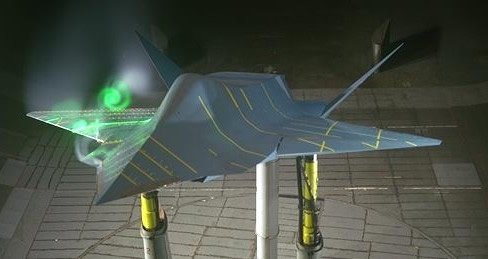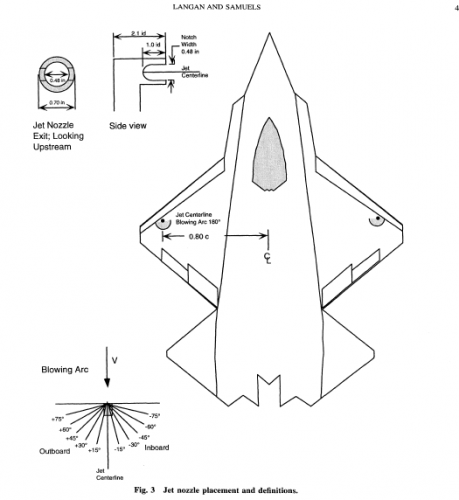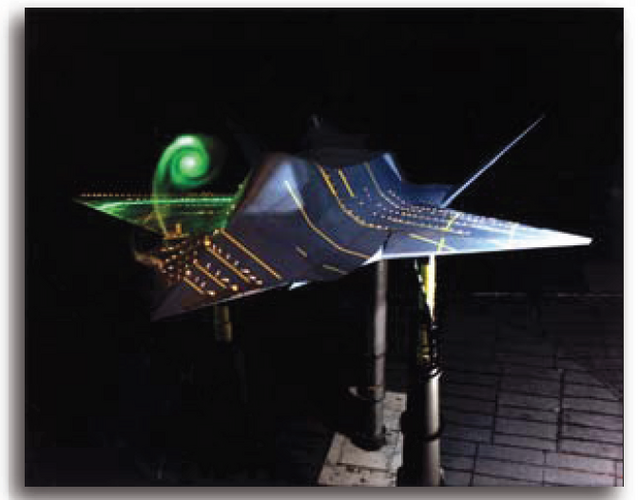- Joined
- 1 April 2006
- Messages
- 11,048
- Reaction score
- 8,472
NASA Ames/USAF Wright Laboratory FLAC/SHARC
Many saw these photos but few (OK, at least I) did know the real background.
AIAA Paper 1993-3516
Small-Scale Wind-Tunnel
Investigation of an Advanced
Fighter Configuration Semi-Span Wing
"Fighter Lift and Control (FLAC) program,
a cooperative research effort between
the USAF Wright Laboratory and the NASA
Ames Research Center. The purpose of thls
experiment was to improve the baseline aerodynamics
of the FLAC wing in the angle-of-attack
range typical of maneuver or combat
Passive and actlve boundary layer control devices
were tested to determine their effectlveness
at delaying separation, and hence improving
maxlmum lift coeffclent and lift-to-drag
ratlo. Various sizes and shapes of vortex
generators, Gurney flaps, and other flow control
concepts were tested. The effectiveness of
tangential blowing an the wing upper surface
also was explored using different mass flow
coemclents. The pneumatics and Gurney flap
showed the most promise for improving the
baseline aerodynamics. Placement of the
vortex generators either forward or aft of the
flow separation point had no significant effect
on the baseline aerodynamics due to the
presence of a leading edge separation bubble."
SHARC
"A large-scale experimental investigation using the 55 percent-scale Subsonic High Alpha Research Concept (SHARC) was
performed in the NASA Ames 40- by 80-Foot Wind Tunnel. The SHARC configuration represents an advanced
low-observable fighter aircraft, and features a clipped diamond wing with leading- and trailing-edge sweep angles of +/- 40
deg, a chined forebody, leading-edge extensions, and a vee-tail. Data covering the angle of attack range of -4 deg through
+42.4 deg and sideslip angles from -10 deg through +10 deg were acquired at a dynamic pressure of 40 psf. Test data are
presented for symmetric and asymmetric wing jet nozzle blowing. Blowing coefficient values ranged from a minimum of
0.005 to a maximum of 0.020. The results indicate that wing jet nozzle blowing is an effective lift enhancement device,
giving an across-the-board net increase in lift over the entire angle of attack range teated. The jets were also found to improve
the aircraft's drag polar. Roll control using asymmetric jet blowing equaled or exceeded that available via the deflection of
only a single aileron."
Many saw these photos but few (OK, at least I) did know the real background.
AIAA Paper 1993-3516
Small-Scale Wind-Tunnel
Investigation of an Advanced
Fighter Configuration Semi-Span Wing
"Fighter Lift and Control (FLAC) program,
a cooperative research effort between
the USAF Wright Laboratory and the NASA
Ames Research Center. The purpose of thls
experiment was to improve the baseline aerodynamics
of the FLAC wing in the angle-of-attack
range typical of maneuver or combat
Passive and actlve boundary layer control devices
were tested to determine their effectlveness
at delaying separation, and hence improving
maxlmum lift coeffclent and lift-to-drag
ratlo. Various sizes and shapes of vortex
generators, Gurney flaps, and other flow control
concepts were tested. The effectiveness of
tangential blowing an the wing upper surface
also was explored using different mass flow
coemclents. The pneumatics and Gurney flap
showed the most promise for improving the
baseline aerodynamics. Placement of the
vortex generators either forward or aft of the
flow separation point had no significant effect
on the baseline aerodynamics due to the
presence of a leading edge separation bubble."
SHARC
"A large-scale experimental investigation using the 55 percent-scale Subsonic High Alpha Research Concept (SHARC) was
performed in the NASA Ames 40- by 80-Foot Wind Tunnel. The SHARC configuration represents an advanced
low-observable fighter aircraft, and features a clipped diamond wing with leading- and trailing-edge sweep angles of +/- 40
deg, a chined forebody, leading-edge extensions, and a vee-tail. Data covering the angle of attack range of -4 deg through
+42.4 deg and sideslip angles from -10 deg through +10 deg were acquired at a dynamic pressure of 40 psf. Test data are
presented for symmetric and asymmetric wing jet nozzle blowing. Blowing coefficient values ranged from a minimum of
0.005 to a maximum of 0.020. The results indicate that wing jet nozzle blowing is an effective lift enhancement device,
giving an across-the-board net increase in lift over the entire angle of attack range teated. The jets were also found to improve
the aircraft's drag polar. Roll control using asymmetric jet blowing equaled or exceeded that available via the deflection of
only a single aileron."

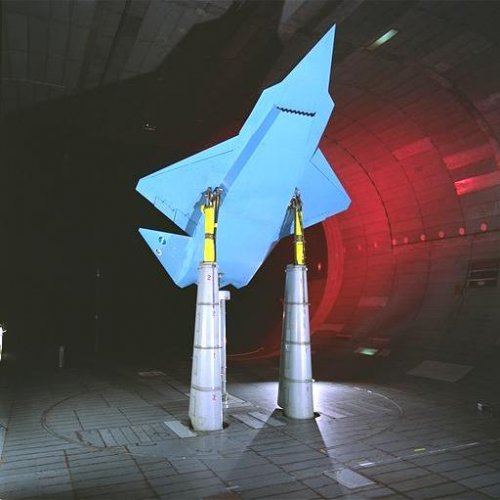
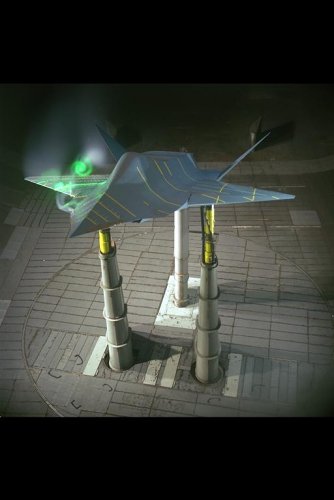
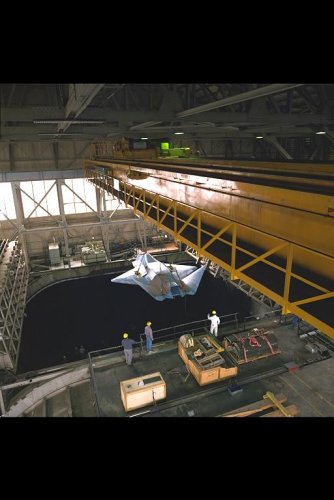
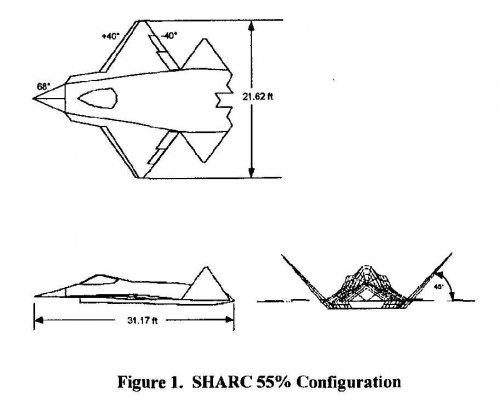
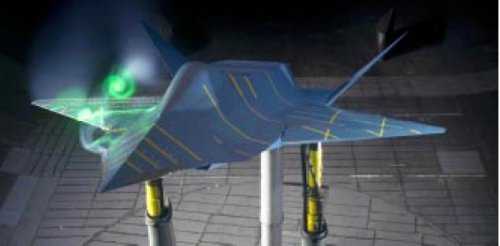
![AC94-0480-43 [1280x768].jpg](/data/attachments/36/36119-a7f689bd0f1a7c835b98a12cd012195f.jpg)
![77919main_AC94-0480-41 [1280x768].jpg](/data/attachments/36/36118-b121b5a60144926948d22dc4aef9e796.jpg)
![AC94-0028-16 [1280x768].jpg](/data/attachments/36/36117-337ed7c9fb01e4124f59cbd2dbfe798f.jpg)
![AC94-0028-14 [1280x768].jpg](/data/attachments/36/36116-5c2b3e97d1cc3656e9fa77ece64efc64.jpg)
![AC94-0028-13 [1280x768].jpg](/data/attachments/36/36115-a396518b87242bdc7413e391cdfb3f25.jpg)
![AC94-0028-12 [1280x768].jpg](/data/attachments/36/36114-130337b1150afca30ac250501501c6c7.jpg)
![AC94-0028-11 [1280x768].jpg](/data/attachments/36/36113-8f29fac4ff7e3e4c38d1ebcc416e545a.jpg)
![AC94-0028-2 [1280x768].jpg](/data/attachments/36/36112-72ce036abdca1756b5a8ea5ed105fe68.jpg)
![AC99-0026-4 [1280x768].jpg](/data/attachments/36/36127-094c653a9547371da099472db66514b1.jpg)
![77918main_AC94-0480-29 [1280x768].jpg](/data/attachments/36/36126-13a171a00846ba48889a4660a93f352f.jpg)
![AC94-0480-48 [1280x768].jpg](/data/attachments/36/36125-e66f0fa208970ce5807500cdf8271852.jpg)
![AC94-0480-45 [1280x768].jpg](/data/attachments/36/36124-1a3650fecf640cd0ca1a2efaf015fc36.jpg)
![AC94-0480-42 [1280x768].jpg](/data/attachments/36/36123-1d3d721bd399a4f110e085e01626a193.jpg)
![AC94-0480-28 [1280x768].jpg](/data/attachments/36/36122-69e2ca17a6df499f6ae0e776f207a441.jpg)
![AC94-0480-27 [1280x768].jpg](/data/attachments/36/36121-9903cc304db37a318009b374426ea693.jpg)
![AC94-0480-26 [1280x768].jpg](/data/attachments/36/36120-1d6c2cff154afeb5c7bd48b4beb483e7.jpg)
